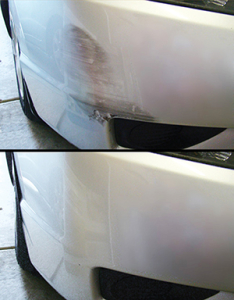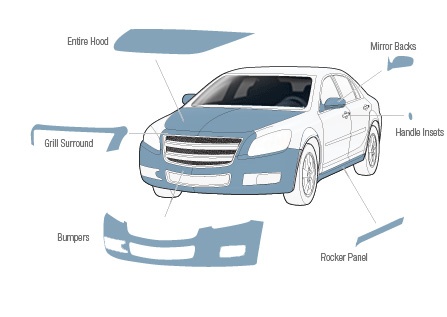Automotive Paint Protection Film - PPF
What is Paint Protection Film?
A clear urethane adhesive film, paint protection film (PPF) can be installed to the surface of your paint and headlamps to provide protection against rock chips, scuffs and light impacts. You can save your headlights from yellowing, haze and “sandblasting” from road grime. Removal of bug guts can also be done without harming your paint.
Why use paint protection film on my vehicle?
PPF film offers a worry-free security for the investment of your vehicle. It will add value to your car and keep your vehicle from forming rust through rock chips.
If you have ever had to re-paint your vehicle or replace cracked headlights or fog lights, you can understand the costs of doing so are much higher than the costs of using paint protection film. Small fender benders where body panels stay in tact, but paint has transferred can also be potentially absolved. The paint from that fire hydrant or from your “friends” bumper will transfer to the PPF rather than your bumper and can simply be changed out for a new piece.
Example: $200 replacement per fog light on a Infiniti FX35, $800 to re-spray and blend a bumper on a Honda Civic. Why not avoid all of these costs with paint protection film?

A PPF protected panel absorbs a bumper scuff and is then replaced with a new piece of Film. Photos from Sharpline.
Who should use this film?
Anyone who wants to retain value and keep their vehicle looking great. PPF works best on clean new paint, however can be installed to older vehicles as well. PPF can be installed over existing rock chips, but is not highly advisable and some disclaimer comes with this installation.
Paint Protection Film uses

Photo by: 3M
Cars, Trucks, SUV’s, Boats, RV’s, Motorcycles, Mountain Bikes, Road Bikes, 4×4’s, Carbon Fibre finishings
Bumpers, Hoods, Fenders, Grill, Mirrors, A-pillars, Roof, Rocker panel, Rear Bumper Deck, Tailgate, Headlights, Fog Lights
Myths of paint protection film
Myth #1 – Paint protection film is yellow
Over time, PPF film has evolved and manufacturers are developing better product against UV fading. We recommend a light wax with UV additives, to be applied to your film every 1 – 2 months to help maintain clarity and visual appearance. If you do not take care of your PPF, yes, over time you may see some darkening or yellowing, but this is not nearly as bad as it used to be with older films. Always remember, you get what you pay for.
Myth #2 – You will cut the paint on my car during installation
Typically a knife only comes out during custom installations where no kit exists or an installer wants to make the kit specific to their needs. With computer technology, has come the pre-cut kit – This means that a company has made a specific kit that fits your vehicle, leaving only 1/16″ along the edges of each panel (it is also possible to do edge wrapping). It is typically more cost-effective to install these “kits” rather than wrapping full panels with PPF. This also means the need for trimming with a blade is also minimized.
Myth #3 – You can not remove PPF film once it has been installed.
PPF is removable through the use of heat and a bit of elbow grease with the adhesive removal chemical. This works best from original factory paint. Under some circumstances, re-painted surfaces have been known to peel, or remove clear-coat with the film. This is best left to a professional to assess, as they will look at the rest of your vehicle to determine condition of the paint.
Price?
There are a range of pre-cut kits for your vehicle. You can choose to cover your bumper, hood, fenders, grille, mirrors, fog lights, headlights, a pillars, roof, trunk deck, etc. It is also possible to specify how much of your hood is covered and make changes to existing kits. Using a pre-cut kit allows us to pass material savings to you and ensure that knife to car time is extremely minimal.
When required, it is also possible to install bulk film for a higher coverage area and no exposed edges – Full hood wraps, etc.
BLOG CATEGORIES
- Art (8)
- Bikes (17)
- Business (34)
- Cars (58)
- Decals & Stickers (136)
- Education (1)
- Garments & Apparel (6)
- Longboarding (4)
- Print (4)
- Residential & Home (9)
- Skiing (5)
- Surfboard Shaping (2)
- Surfing (6)
- Video (7)
- Vinyl & Sign Installation (60)
- Vinyl wraps (3)
